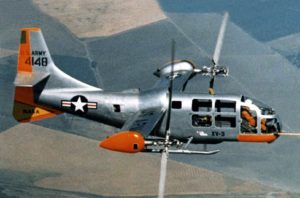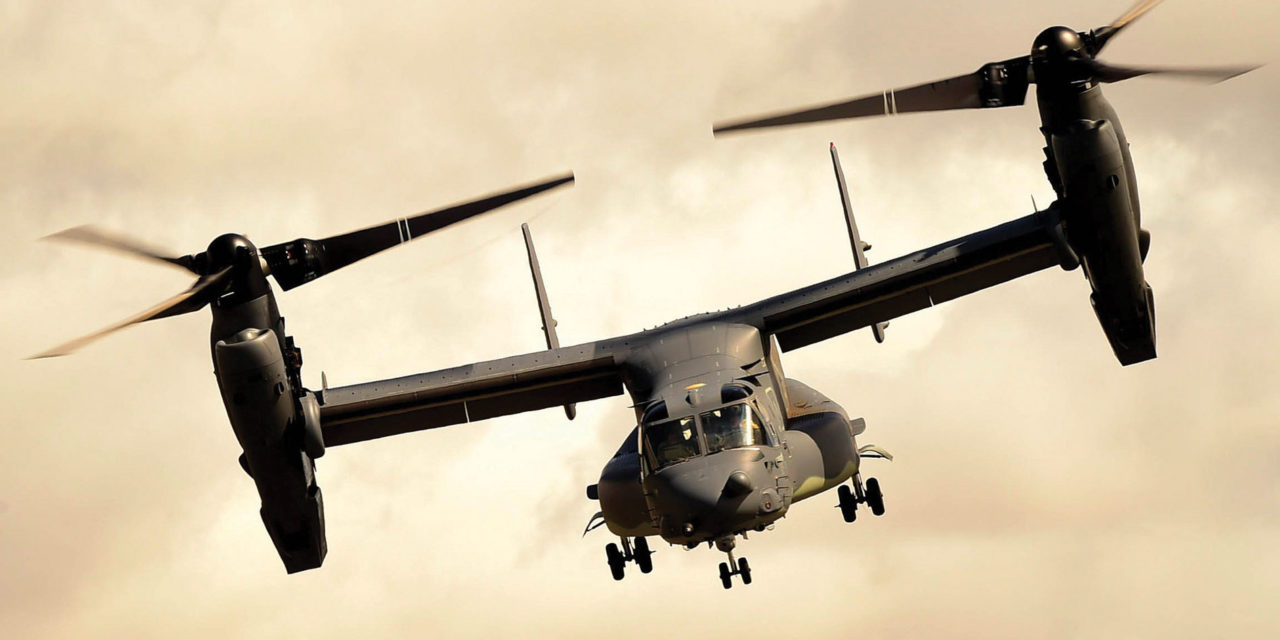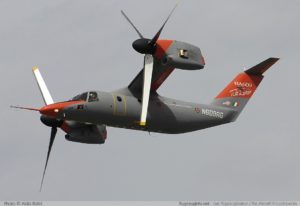Hindustan Aeronautics Limited (HAL), which has been tasked with designing and developing the Indian Multi Role Helicopter (IMRH), a medium-lift helicopter for the Indian Armed Forces, is eager to begin work on India’s tiltrotor aircraft programme in the mid-next decade, as tiltrotor technology is rapidly maturing and will soon be as affordable as current helicopters.
Tiltrotor technology as name suggests can tilt and direct the thrust they generate towards the ground to allow it to take off and land vertically, and then adjust their positions to send that thrust backwards in forward flight, much like traditional aircraft propellers is biggest revolution in helicopter technology in last 40 years but the technology is still niche and expensive for which HAL’s The Rotary Wing Research & Design Centre (RWR&DC) and Aircraft Research & Design Centre (ARDC) are working together to create multiple flexibility studies.
HAL believes that the tiltrotor engine will be the most difficult to overcome, but as more OEMs invest in the research and development of such engines for both military and civilian space applications, availability of such engines will increase by the end of this decade.
Tiltrotor technology allows any aircraft to land and take off like a helicopter and then flies like an airplane. No Helicopter can compete with a tiltrotor when it comes to speed and range.
ALSO READ: P-8 Challenger : Dassault-Airbus to develop MPA based on A320Neo
Tilt- Rotor Technology and Development
Helicopters are extremely versatile platforms that are used both for military and non-military tasks. The problem encountered in helicopters is primarily its speed and range of operation. It has been impossible to design these machines with their rotors mounted atop, beyond a certain point. However, tilt-rotor technology provides the wherewithal for new wave of helicopters that will make these machines flu both faster and longer. The author provides an insight into the significant steps that have been traversed by major helicopter manufacturing concerns in reaching the current status.
Tilt-Rotor Concept

Image Courtesy: Aviastar
Ever since the development and flight of the first practical helicopter, the VS-300 in 1943 by Igor Sikorsky, the father of modern helicopters, thousands of man-hours and billions of dollars have been spent on improving the helicopter design in order to make it fly farther and faster. However, due to the engineering and aerodynamic constraints related to helicopters, the design approaches over the years have not yielded any significant results. Most of the rotary-wing machines today are limited to speeds of approximately150 knots at the top end and a range of around 350 Nautical Miles.
One of the most significant aerodynamic factors limiting the speed of a helicopter is a phenomenon known as ‘retreating blade stall.’ As the helicopter’s forward speed increases, the retreating blade will reach a point where the blade tip, the area of the blade rotating the fastest reaches its critical angle and stalls, causing loss of lift, buffet, vibrations and ultimately loss of control. Concerted efforts have been made by major helicopter giants like Bell, Sikorsky, Boeing and Airbus to overcome this ‘phenomenon’ in the last decade plus, but with limited success.
The development of various experimental models as technology demonstrators by Airbus (X2, X3 & X4) and Sikorsky (X2 co-axial compound helicopter), wherein the main emphasis was on increasing speed and load carriage capacity, are pointers in this direction. While many of these designs go well beyond the tried and tested rotor and propeller system that has defined generations of helicopter technology, the gains have been limited.
Finally, if the designer has to rely on a rotating blade to provide the majority of lift for the rotorcraft, retreating blade stall will produce a barrier to top speed, efficiency and range – hence the only way to overcome this problem was to look at the concept of merging the attributes of a helicopter with a fixed-wing aircraft. This meant that during cruise flight, the aircraft should rely on a wing to produce the lifting force and the rotors must morph from providing all of the lift while in the hover, to producing all of the propulsive force in wing-borne cruise flight – basically called the Tilt-Rotor. To make this concept a reality has been one of the greatest challenges faced by aeronautical engineers and aerodynamicists since the advent of modern helicopters.
ALSO READ: Embraer offers the Indian Armed Forces its A-29 Super Tucano
Tilt- Rotor Development

Image Courtesy: WeapoNews
The first recognised model of a tilt rotor is the 1-G single seat tilt- rotor with a centrally mounted Lycoming O-290 piston engine. This was developed in 1952 by some lesser known pioneers in the US, as part of a military contract. While the 1-G crashed in 1955, it was able to carry out some flights where the prop-rotor drive shafts had been tilted to within 10 degrees of the horizontal airplane mode. This vehicle therefore is recognized as the first to explore transition from vertical flight to wing-borne airplane flight.
This was closely followed by the design and development of the Model XV-3 by Bell Aircraft again through military funding. The XV-3 was similar in configuration to the 1-G, with the Pratt & Whitney R-985 piston engine centrally mounted in the fuselage, except that the aircraft was almost three times the weight of the Model 1-G. This model faced a lot of problems related to rotor instability and heavy airframe vibrations, factors responsible for the crash of the XV-3 during a flight in October 1956.
The company made a number of modifications to the existing XV-3 model and finally successfully completed the first full transition from helicopter to airplane mode in December 1958.The XV-3 was also instrumental in defining flight control systems in this new breed of flying machine. Tilt-rotors that followed the XV-3 broadly copied its flight control systems, albeit with more and more levels of sophisticated automation. The XV-3 had certainly proved that the concept of the tilt-rotor was achievable, but it was only able to achieve a speed of 115 knots, a marginal increase over most conventional helicopters of that time – however, the flame for the tilt -rotor concept had been lit, generating a keen interest in the Helicopter industry and the American Military who had funded these programs and were keen on its success.

Image Courtesy: Classic Airliners & Vintage Pop Culture
Encouraged by the XV-3 and subsequent experimentation and research into aero-elasticity by NASA, wind tunnel tests of large prop-rotors by Bell Helicopter and Boeing and further research into flight control systems by Vought Aeronautics, NASA and the Army Air Mobility Research and Development Laboratory initiated the Tilt- Rotor Research Aircraft project in 1971.
The project was to consist of two stages, with stage one producing a preliminary design for a minimum size proof-of-concept vehicle and stage two development of the vehicle. In April 1973, Bell Helicopter was selected to design and build two tilt-rotor research aircraft for a target cost of $26.5 million and the designation XV-15 was allocated to the project. The first prototype of XV-15 was officially rolled out in 1976 at Bell’s Fort Worth facility, Texas. Because of its relatively small size, the aircraft lent itself well to ground-running tests both in helicopter and airplane mode.
Extensive tests were carried out on the XV-15 and it made its first brief hop in May 1977, in a profile that maintained all loads at the minimum values. The flight envelope of the XV-15 was expanded cautiously under direction from NASA and the second prototype of XV-15 carried out the first transition to wing-borne flight in July 1979.
What followed over the next 20 years was arguably one of the most successful flight-test career of any NASA X-plane (Tilt-Rotor). The XV-15 proved the tilt-rotor concept could be turned into a practical aircraft with varied military and civil applications. The most significant development was its participation and performance at the Paris Air Show in 1981, where it became the show stopper leaving the industry, the military and the public spell bound and arousing the interest of a number of participating countries.

Image Courtesy: Helicopter Industry
ALSO READ: Conference Brochure reveals DRDO’s HSTDV Final Configuration
V-22 OSPREY
Despite the XV-15 funding by the US army, it was the US Marine Corps which took the lead by looking at the tilt-rotor as the most suitable aircraft to replace its aging fleet of CH-46 Sea Knights and CH-53D Sea Stallions. Accordingly in 1982, a request for proposals was issued under the project name Joint Services Vertical Lift and Experimental (JVX). It was the Bell-Boeing joint collaboration which took on the contract in 1983, which spelt out the parameters to be achieved – the aircraft should be able to fly at 250 knots, at altitude of 25000 feet, carry 24 fully armed soldiers and operate from the ship decks.
The first prototype JVX, now the famous V-22 Osprey flew at Bell’s research facility at Fort Worth on March1989 and completed the first full transition to airplane mode in September 1989.The flight test phase of the V-22 Osprey lasted 16 years and was dogged by numerous technical difficulties and accidents including budgetary constraints. Despite these impediments, the first deliveries of V-22 Osprey were made to the Marine Corps in 2005. The V-22 has since flown more than 400,000 hours in various combat theatres including Iraq and Afghanistan and is in service with the US Marines and Air Force- in 2020 it is expected to enter service with the US Navy-there are approximately 500 V-22 Osprey’s operating in the US
Programmes for Civilian use of Tilt-Rotor Helicopters

Since its inception, the tilt-rotor was predicted to have civilian as well as military applications, so it was no surprise that in 1996, Bell-Boeing announced its intention to produce a civil tilt-rotor design. This was the Bell Boeing 609 (BB609) design based on experience with the XV-15 and the V-22 Osprey. The two-crew aircraft was designed to carry nine passengers and have a maximum speed of 275 knots over a range of 750 nm. However in 1998 Boeing withdrew from the program and Agusta, a participant in the European Future Advance Rotor-craft project (EUROFAR), formed a joint venture with Bell to develop what was renamed as the BA609 (Bell-Agusta).
The first prototype flew in March 2003 at Bell’s Fort Worth facility. By October 2008, two prototypes had logged 365 hours in both airplane and helicopter mode and in 2009 it successfully demonstrated a dual engine failure in cruise flight. However, with Bell’s focus shifting to military applications of the tilt-rotor and with its ongoing ambitious V-280 Valor project, Agusta-Westland formally purchased Bell’s share in the project and renamed it as the AW609.
Flight testing was halted in October 2015 after the second AW609 prototype crashed during a high-speed test flight, killing both the pilots. Testing resumed in April 2016 and the third prototype joined the program in May 2016 to carry out icing trials. The fourth prototype is in final production, and with orders already pouring in from a number of countries the AW609 program appears to be making a recovery and is aiming for certification in early 2019 with deliveries expected to commence in 2020 – Countries like UAE have already shown an interest in the AW609.
FUTURE DEVELOPMENTS

Image Courtesy: Wings Herald
Bell having concentrated on its military programs, has now successfully flown its V-280 Valor, part of the US Military’s Joint Multi Role technology demonstrator programme, in collaboration with Lockheed Martin. In December 2017, the Bell V-280 tilt-rotor took to the sky under its own power for the first time, paving the way for starting the long and rigorous flight testing program. The V-280 is expected to have a speed of 280 knots and combat radius of 2100 NM. Meanwhile, the V-22 Osprey fleet is expanding rapidly driving the tilt-rotor to a level of maturity that was a distant dream when the XV-15 took to the skies.
In the civil domain Agusta Westland now Leonardo Helicopters, is planning to fly its next-generation civil tilt-rotor in 2021. The 20-passenger rotorcraft which is much larger than the in-development nine seater AW609, is in the conceptual design stage, with a cruise speed expected to be close to 300 knots. Leonardo believes that a pressurized tilt-rotor fills the gap between helicopters and turboprops in terms of speed and altitude, the latter allowing flight above the weather. The unmanned segment is also looking at the benefits of this technology with Bell’s Eagle Eye tilt-rotor UAV programme. The next decade will certainly belong to the Tilt-Rotor.